In a country whose media landscape is far from neutral, and heavily saturated with fake and sensational news, it becomes critical that a guideline be established for responsible use of language and rights based perspective when covering a beat as sensitive and fundamental as menstruation. A piece of news should spark conversations that help the efforts being made to destigmatise the matter and critique the perpetration of taboos.
Part one of this article delves into why mainstream media must use inclusive language and evidence base to report on menstruation sensitively.
Read part two: How Can Mainstream Media Expand The Range Of Issues When Reporting On Menstruation
1. Keep Menstruators at Centre-stage
Several articles/videos hypothesise (cis)men getting periods or wearing period products, and sometimes explicitly laud cis men that take up initiatives to fight period poverty but don’t give such special coverage to women working in the space.
This perpetuates the discourse that men’s needs are more valid and it is only through juxtaposition of menstruators’ needs over men will the latter get attention.
In 2015, WaterAid released a series of ads spoofing the hypothetical scenario that we would see #IfMenHadPeriods. Converge surrounding it noted the ad’s tongue in cheek nature, as demonstrated in the below excerpt from Mirror UK, and another one by Global Citizen shared the perspective of the CEO of WaterAid about the series:

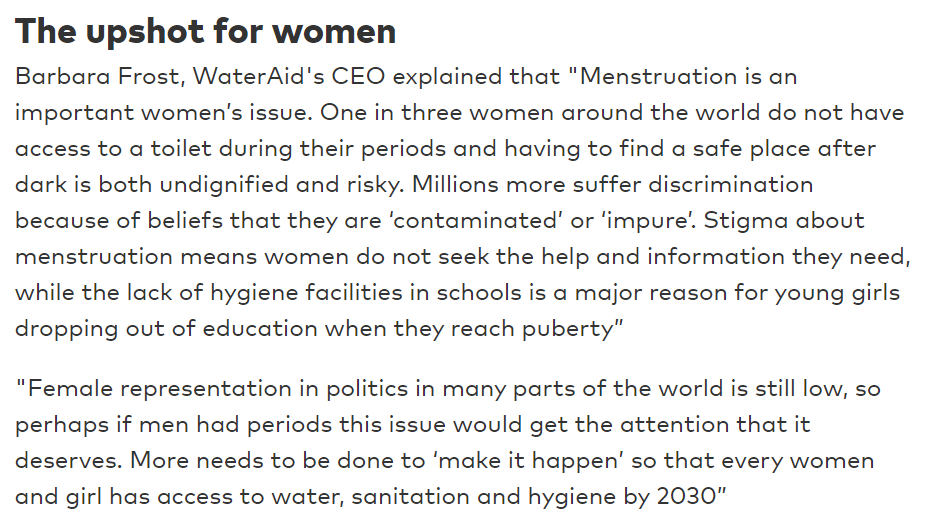
In 2016, the #IfMenHadPeriods went viral again when gynaecologist Jen Gunter started a thread with the hashtag on Twitter to highlight the sexism that is at play in keeping menstrual rights at far reach for menstruators.
However, this time around, the mainstream media did a much more responsible coverage!
The hashtag was criticised on Twitter and subsequent media reports for not being explicit that the tag was targeted only at cis men and perpetuated the erasure of trans men’s and non binary folks experiences of menstruation.
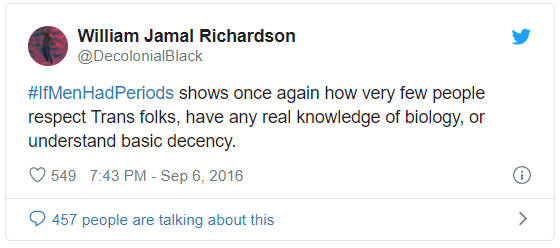
The Daily Beast’s article gains extra credibility because it was written by a trans man as a personal story rather than a cis person talking on behalf of gender nonconforming menstruators.
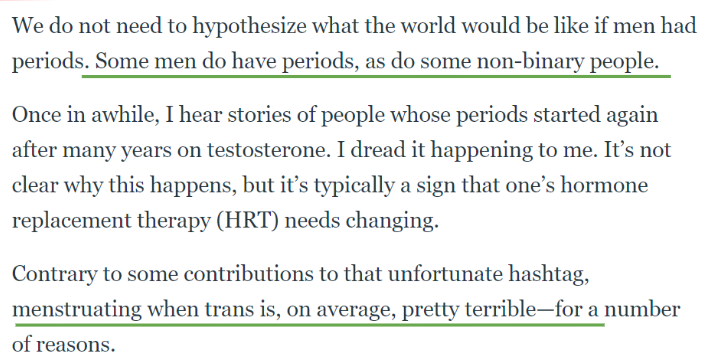
2. Inclusive, Positive Language
Example 1 — ‘Suffers from’ versus ‘Lives with’
While most of the coverage around menstruation focusses on ‘hygiene’, the few articles that do talk about health and disorders, refer to menstruators ‘living with’ disorders as sufferers, adding to the already heavy stigma around disorders as demonstrated by these articles in The Hindu and The Times of India.
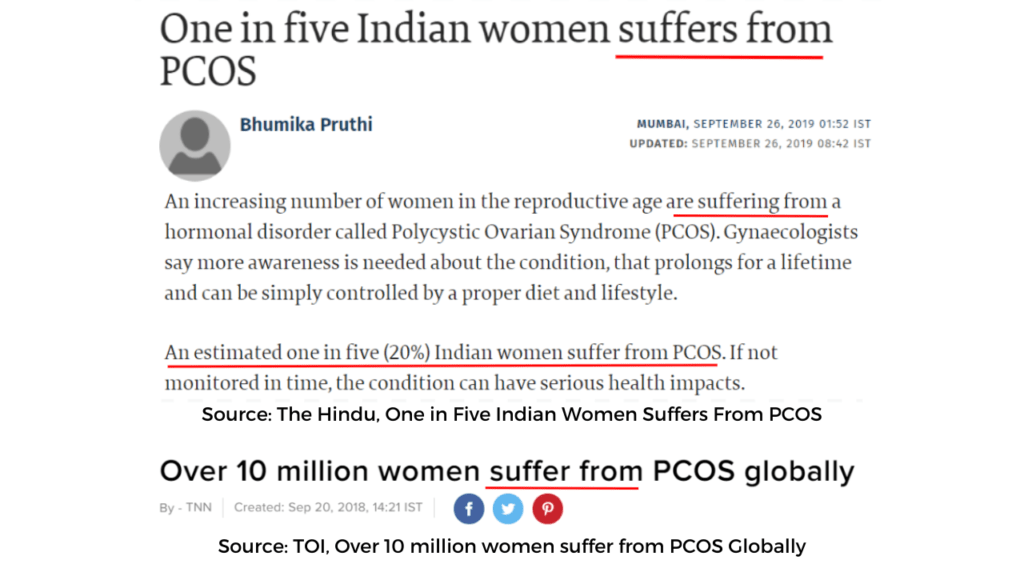
Considering that 20% of all menstruators live with PCOS and 10% with endometriosis, it is essential that we normalise this condition’s occurrence by championing narratives where menstruators find ways to cope with the condition.
It is important to use positive language in reporting about sensitive topics in order to not ostracise or blame them.
This NDTV article is a good example of a more suitable, neutral language, using words like ‘have PCOS’ or are ‘impacted’. It also sets the precedent that it is manageable, making it less daunting for a lay person to read:
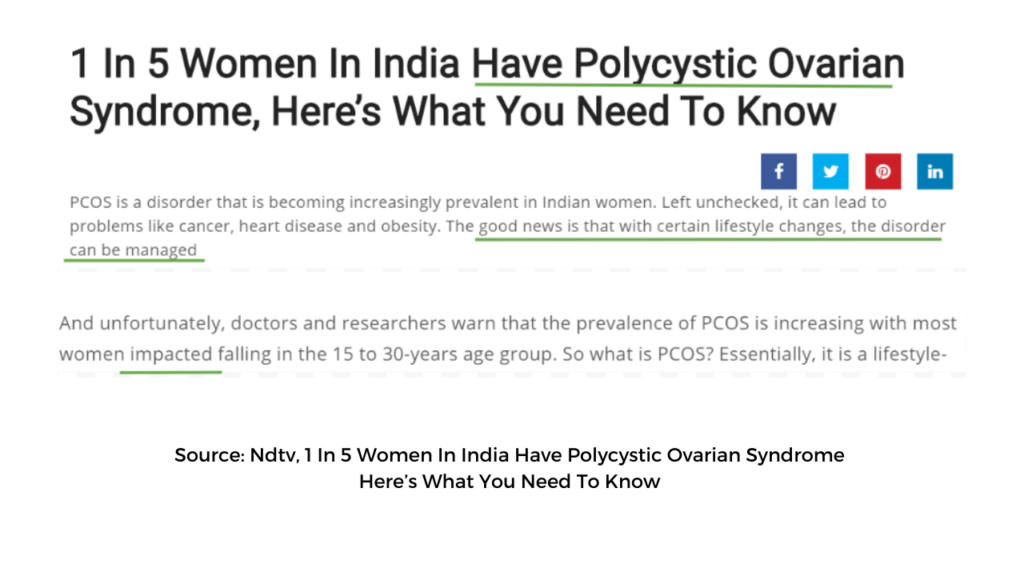
Example 2 — ‘women’ versus ‘menstruators’
Several articles across outlets report on menstruation as a ‘women’s issue’ playing into the culture of trans erasure and lack of male stakeholder responsibility when talking about menstruation. This Huffpost article goes out of its way to invalidate gender non-conforming menstruators and erases the possibility of gender affirmative surgery by saying ‘no one can change sex’.
Besides a triggering headline, the article itself is transphobic and aggressive in tone and yet, published as a blog on a platform as widely read as HuffPost which makes one wonder how much attention editors pay to the far-reaching impact of reportage, even if Op-ed.
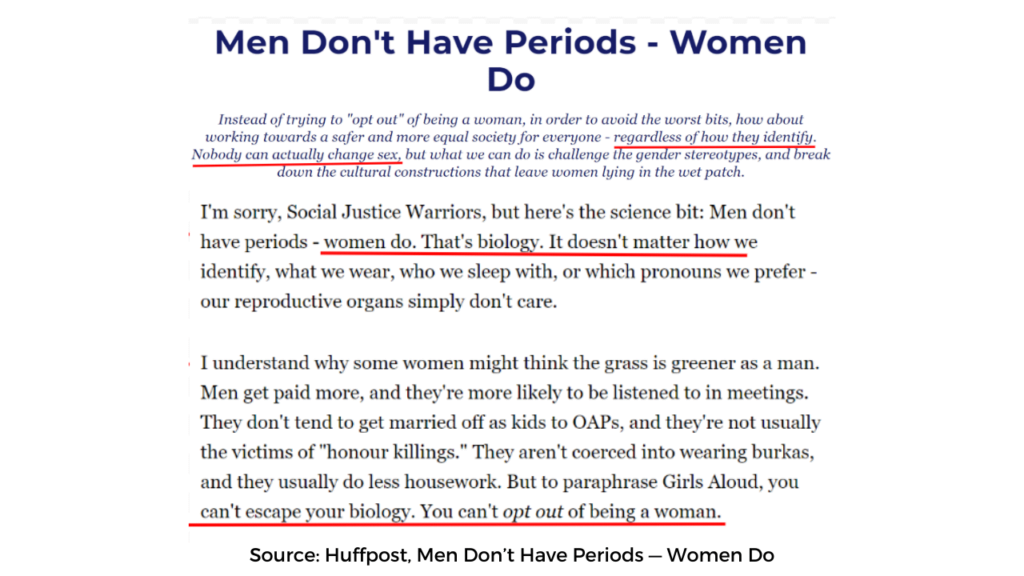
Across several articles reviewed, it was noticed that when talking about menstruation, the subjects are always referred to as a binary word ‘women’ rather than its more inclusive alternative ‘menstruators’.
3. Sensationalism in Headlines
In a media space that is replete with sensationalism or ‘clickbait’ as a way of getting readership, reporting on menstruation is no exception. A Quint article makes a sensational headline out of a very controversial comment made by a religious leader claiming that menstruators would be born as ‘bitches’ if they cooked for husbands while menstruating.
The headline doesn’t serve the purpose of summarising the piece and its contents, rather only acts as click bait adding no contextual value to clarify that the piece is about menstruation or that it is the ‘karma’ of cooking on period that’s being talked about.
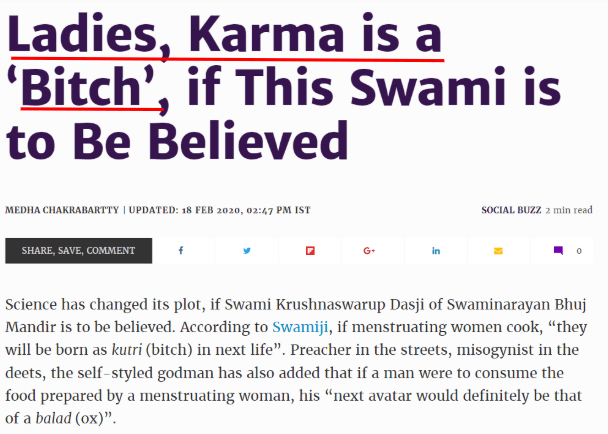
4. Cite Accurate Data with the Source
In order to ensure that misinformation and taboo around menstruation is curbed, it is pertinent for mainstream media to avoid ‘claiming’ realities by mentioning numbers and percentages without attaching the source links below the article or hyperlinking it.
Consuming news through online spaces allows one to actively engage with what is presented. Leaving room for criticism directly influences quality research on any subject. In the case of menstruation, positions taboos in perspectives. However, most articles like the one by Outlook India below do not welcome engagement, at the outset.
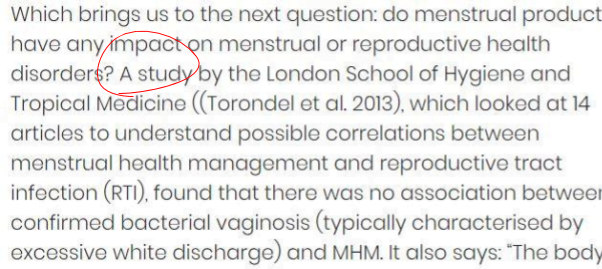
The data heavy article explains the myth around rural girls being more affected by MHM availability with data taken from a ‘study’. Unfortunately, to get any context on these numbers, one would have to watch a Ted talk on ‘Menstrual Health in India’ delivered by the writer, Sinu Joseph.
Even though reporters take references from wire agencies/ pre-existing articles , it is important to be accountable for what one publishes. While some articles do mention the title of the paper referred to support their narrative, some fail to mention if the paper is available for public viewing or can only be viewed by subscribers. Like this one from Forbes India.

Although the statistics from the Nielsen report are widely used, it isn’t made clear that the report itself, as a paper, is nowhere to be found, neither on their own website nor on any other public domain. Even this must be mentioned in the article.

However, articles that do state that unavailability of the source do exist sparsely. An article by The Logical Indian, clearly states that the study titled ‘Sanitary Protection: Every Women’s Health Right’ is not available on any public domain.

5. Absence of Expert Opinions
This February we witnessed sensational coverage around Swami Krushnaswarup Das’s comment on menstruating women who cook. Most of the articles published around this ended up being a platform for the retelling of Swami’s misogynist comment, like this excerpt from The National Herald.
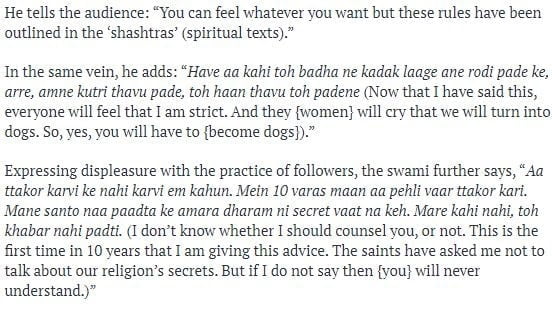
Even after three paras of quotes, it continues.
There were very few articles where quotes and opinions of government officials, renowned feminists, menstruating stakeholders etc. were included. Only one of the several we read, had highlighted what a woman in the government had to say about it.
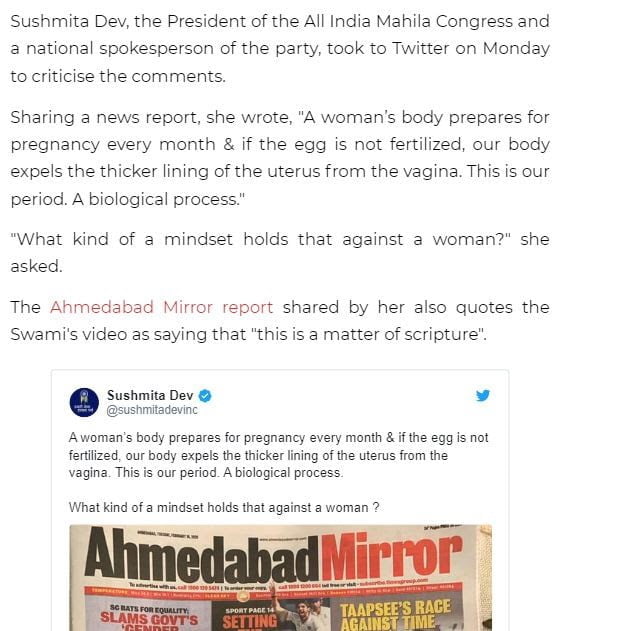
6. Be Critical, Hold People Accountable
Being critical of all events and testing accountability is a critical part of why the media plays the role of check and balance in the grand scheme of things. Most articles around menstruation however, are exclusively documentation: documentation of success stories and documentation of shame/superstitions in rural India.
Menstruation needs critical analysis. There are stakeholders like the larger government bodies, municipalities/panchayats, menstrual health management researchers, waste management organisations, medical fraternities etc. There are stories that do demand follow up and one particular account of such reportage is mentioned further into the article. However, most organisations overlook opportunities for a critical story around menstruation.
An HT piece, for instance, talks about concerns with sanitary waste disposal, completely misses an investigative opportunity. The article clearly specifies that according to ‘Bio- Medical Waste (Management and Handling) Rules, 1998’ items contaminated with blood and body fluids must be incinerated or microwaved. But that is clearly not applied. While the piece has comments from researchers and environment educators, it does not take the story to the government stakeholders involved. The waste pickers are employees of the state government, questioning the authorities involved from a local level can add a lot of credibility to the story and value to readers alike.

Another instance of a follow up missed would be the coverage around installation of a sanitary pad machine in a women’s prison in Lucknow.

This story too is a mere documentation with no follow up to see if it is functional, a viable business model with distribution channels, but most importantly if it is being used by menstruators (prisoners, warders) in the enclosures.
Also read: How Did The Indian Media Cover Menstruation During The Pandemic?
This article is part of Boondh’s #PeriodsandPatrakaars campaign, whose goal is to enable writers with inputs from various stakeholders (media Houses, journalism students, MHH and waste practitioners, cis menstruators, sports menstruators, vulnerable menstruators including trans, queer, disabled, Dalit Adivasi, prison menstruators, people living with menstrual disorders) with skills to improve the quality of menstrual reporting through a reporting toolkit.
Authors’ Note: This excerpt of suggestions has been structured based on coverage related to menstruation in news and some popular media within India and a few from outside with citation versions of the pieces as on 22nd March, 2020. The goal of these citations is only to drive a point home, problematise the content and not defame the publisher.
If you are a journalist reporting on gender, health or sanitation, do reach out to Boondh via Twitter! To make #ResponsibleRedReporting a reality, your inputs will add great value to this initiative. For details, write to pratyusha@boondh.co
This article has been previously published here.





Kudos to the writers who have brought to the audience some valid and insightful points that should be kept in mind while voicing opinions. I’m sure this is going to be very helpful.